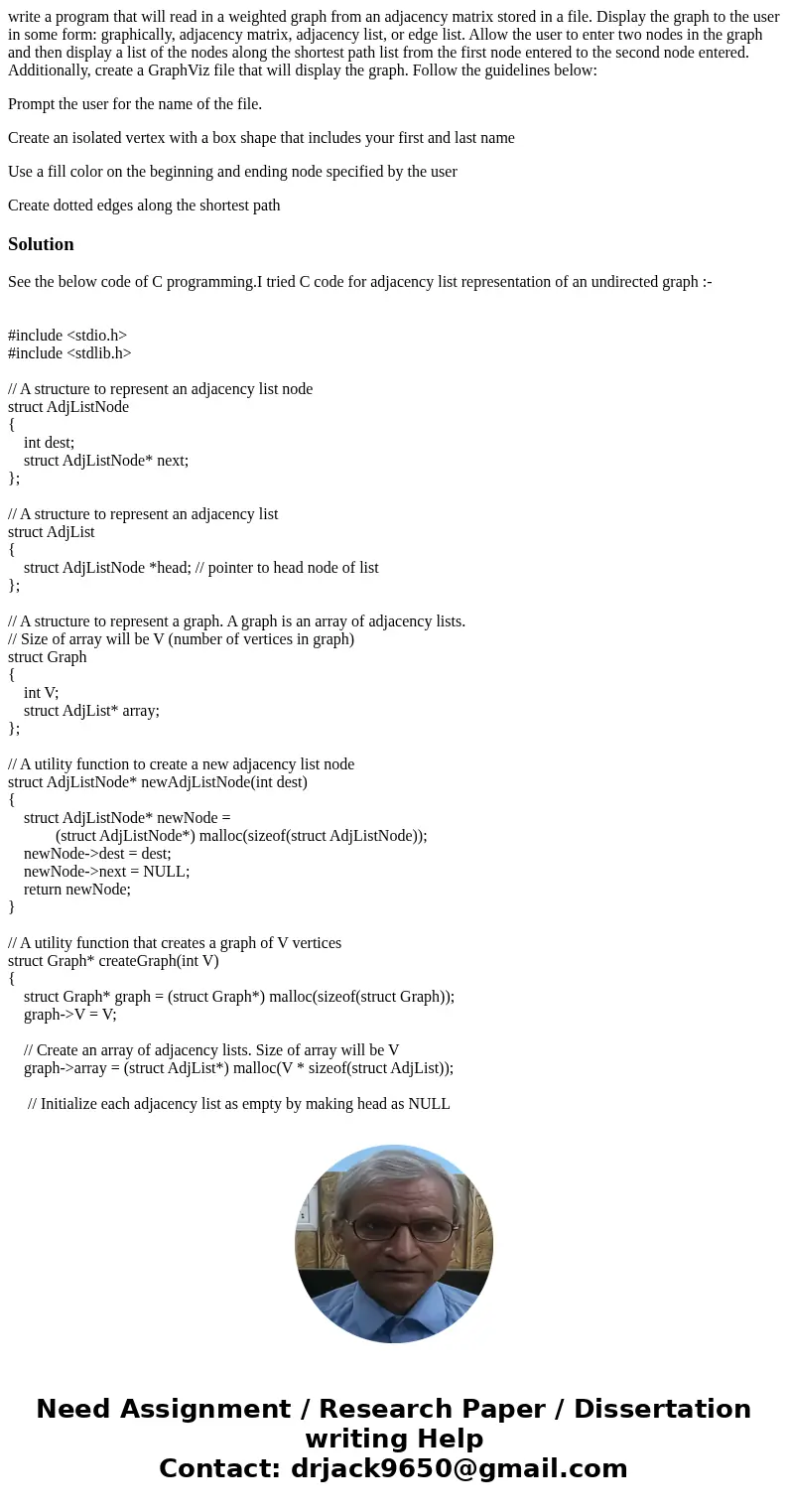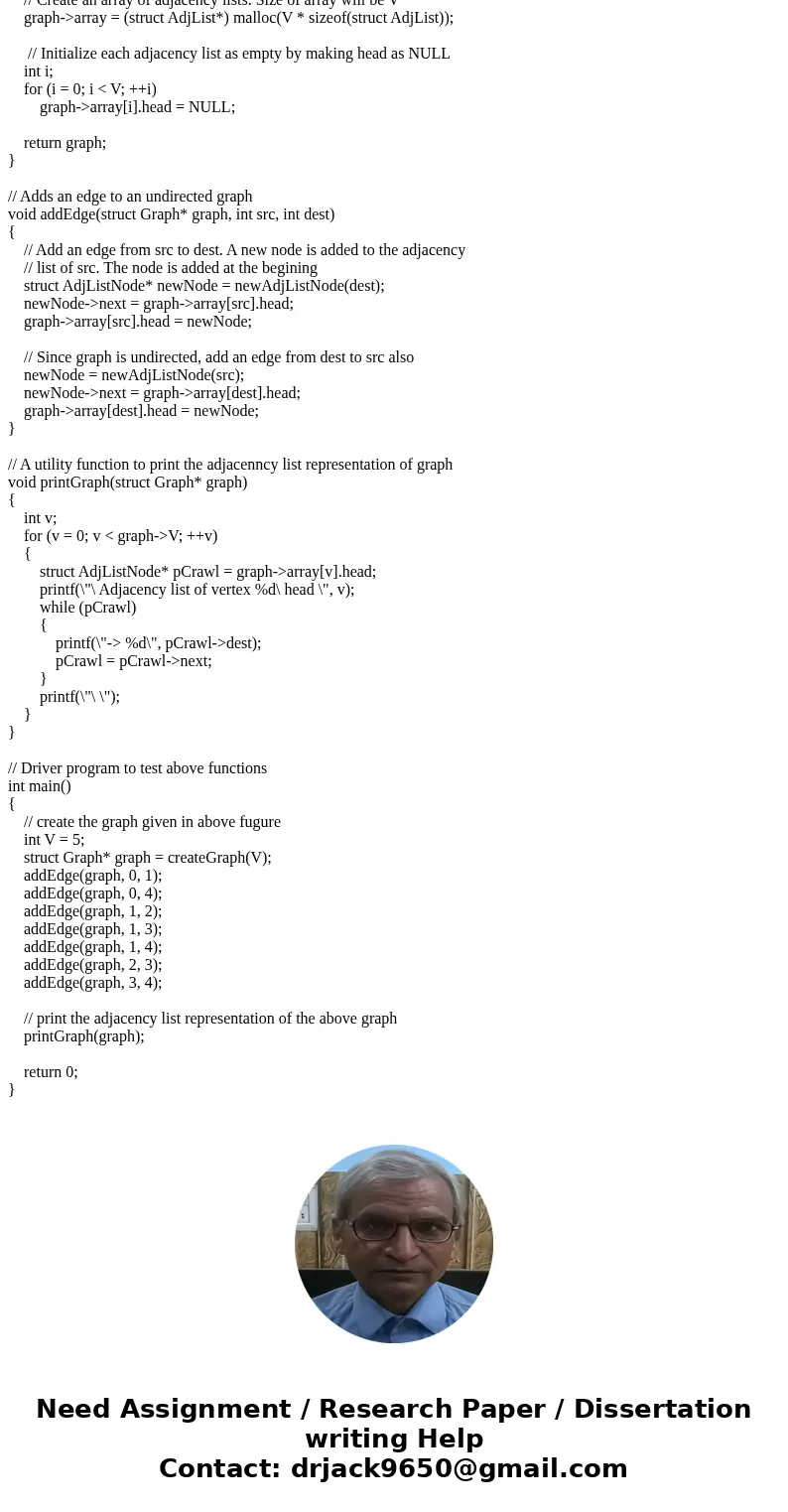write a program that will read in a weighted graph from an a
write a program that will read in a weighted graph from an adjacency matrix stored in a file. Display the graph to the user in some form: graphically, adjacency matrix, adjacency list, or edge list. Allow the user to enter two nodes in the graph and then display a list of the nodes along the shortest path list from the first node entered to the second node entered. Additionally, create a GraphViz file that will display the graph. Follow the guidelines below:
Prompt the user for the name of the file.
Create an isolated vertex with a box shape that includes your first and last name
Use a fill color on the beginning and ending node specified by the user
Create dotted edges along the shortest path
Solution
See the below code of C programming.I tried C code for adjacency list representation of an undirected graph :-
#include <stdio.h>
#include <stdlib.h>
// A structure to represent an adjacency list node
struct AdjListNode
{
int dest;
struct AdjListNode* next;
};
// A structure to represent an adjacency list
struct AdjList
{
struct AdjListNode *head; // pointer to head node of list
};
// A structure to represent a graph. A graph is an array of adjacency lists.
// Size of array will be V (number of vertices in graph)
struct Graph
{
int V;
struct AdjList* array;
};
// A utility function to create a new adjacency list node
struct AdjListNode* newAdjListNode(int dest)
{
struct AdjListNode* newNode =
(struct AdjListNode*) malloc(sizeof(struct AdjListNode));
newNode->dest = dest;
newNode->next = NULL;
return newNode;
}
// A utility function that creates a graph of V vertices
struct Graph* createGraph(int V)
{
struct Graph* graph = (struct Graph*) malloc(sizeof(struct Graph));
graph->V = V;
// Create an array of adjacency lists. Size of array will be V
graph->array = (struct AdjList*) malloc(V * sizeof(struct AdjList));
// Initialize each adjacency list as empty by making head as NULL
int i;
for (i = 0; i < V; ++i)
graph->array[i].head = NULL;
return graph;
}
// Adds an edge to an undirected graph
void addEdge(struct Graph* graph, int src, int dest)
{
// Add an edge from src to dest. A new node is added to the adjacency
// list of src. The node is added at the begining
struct AdjListNode* newNode = newAdjListNode(dest);
newNode->next = graph->array[src].head;
graph->array[src].head = newNode;
// Since graph is undirected, add an edge from dest to src also
newNode = newAdjListNode(src);
newNode->next = graph->array[dest].head;
graph->array[dest].head = newNode;
}
// A utility function to print the adjacenncy list representation of graph
void printGraph(struct Graph* graph)
{
int v;
for (v = 0; v < graph->V; ++v)
{
struct AdjListNode* pCrawl = graph->array[v].head;
printf(\"\ Adjacency list of vertex %d\ head \", v);
while (pCrawl)
{
printf(\"-> %d\", pCrawl->dest);
pCrawl = pCrawl->next;
}
printf(\"\ \");
}
}
// Driver program to test above functions
int main()
{
// create the graph given in above fugure
int V = 5;
struct Graph* graph = createGraph(V);
addEdge(graph, 0, 1);
addEdge(graph, 0, 4);
addEdge(graph, 1, 2);
addEdge(graph, 1, 3);
addEdge(graph, 1, 4);
addEdge(graph, 2, 3);
addEdge(graph, 3, 4);
// print the adjacency list representation of the above graph
printGraph(graph);
return 0;
}


 Homework Sourse
Homework Sourse